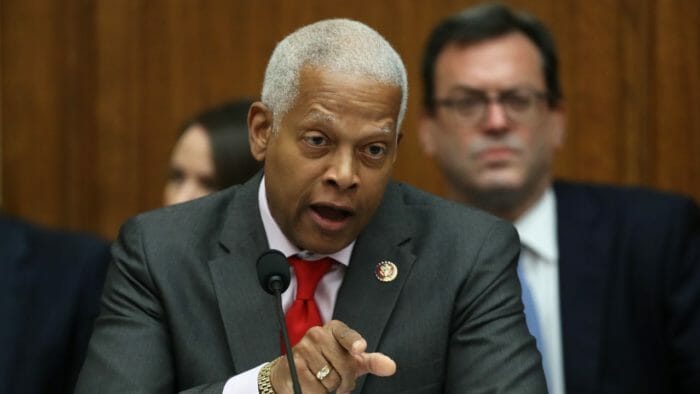Bill in Congress Would Make Every Semi-Auto Rifle an Assault Rifle
While most of the United States is under various local and state directives to stay home and reduce economic activity due to Coronavirus (COVID-19), Congress is not on hiatus. A sweeping bill to restrict gun rights, as well as firearm and ammo sales, is slowly making its ways through the backchannels of the U.S. House of Representatives.
Rep. Hank Johnson (D-Atlanta) has authored H.R. 5717 – the “Gun Violence Prevention and Community Safety Act of 2020” – which would mandate universal background checks of public and private sales, institute seven-day waiting periods, extend the definition of an assault rifle to every semi-automatic rifle, create stringent “red flag” requirements, and even add a licensing requirement to purchase guns or ammunition.
To say it is wide-reaching is an understatement. Rather, the bill spells out every major policy objective anti-gun activists have reached for over the last several decades. At least one gun rights organization has dubbed it “gunpocalypse.”
Beware: It's a lot
Rep. Johnson’s bill, introduced in January, is another of many “assault weapons” bans – a concept bolstered by the Supreme Court’s Remington vs. Soto decision in December 2019, which allows for consumer lawsuits against manufacturers of guns. Although these kinds of lawsuits rarely result in verdicts against the manufacturer, anti-gun groups have used this kind of expensive litigation as a tactic to cause financial harm to firearms companies.
Johnson’s bill would make it illegal “to import, sell, manufacture, transfer, or possess, in or affecting interstate or foreign commerce, a semiautomatic assault weapon.”
What kind of “semiautomatic assault weapon” you might ask? The bill defines the term as any firearm with the functionality of accepting a detachable magazine and featuring either a pistol grip, forward grip, grenade launcher, barrel shroud, threaded barrel, or a folding, telescoping, or detachable stock.
Background check requirements are strengthened, including the introduction of “red flag” processes. Heavy taxes would be imposed, including a 30 percent tax on firearms and 50 percent levy on ammo. Also, the bill seeks to require state law enforcement authorities to be notified when a background check is denied, also requiring state attorneys general to submit annual reports to Congress highlighting the number of background check denials.
The bill would also require all gun owners to obtain a federal firearms owner’s license to purchase guns, regardless of model or year of manufacture of the firearms they are purchasing, while grandfathering previously purchased firearms. Only one firearm may be purchased per 30-day period.
The ban has a few noteworthy exceptions. Law enforcement officers would not need a license and may carry semiautomatic firearms, as can those providing security at “critical infrastructure” (think public sports arenas or power plants). And unlike a recent European Union directive, permanently inoperable firearms with bolt, slide, lever, or side action that has been fused shut are exempt, as are antique guns.
Does it have a shot?
Gun rights activists, including the Military Arms Channel’s robust Facebook community, were early on the scene to sound the alarm, followed by Gun Owners of America and the National Rifle Association. Campaigns are underway asking their constituencies to call their representatives in an attempt to stop the bill in its tracks. Fortunately for gun rights supporters, the tracks are not very deep.
But here’s where an otherwise doomed bill may have gained some unprecedented traction: Johnson, who sits on the House Judiciary Committee, was joined by then-presidential contender Sen. Elizabeth Warren (D-Mass.) who introduced her version of the bill, S.3254, in February. The Senate bill gained some notoriety during Warren’s stump speeches. She dropped out of the presidential race on March 5 but was in long enough to shine a spotlight on the bill.
“The Gun Violence Prevention and Community Safety Act will save lives and make our country safer – without infringing on any law-abiding individual’s right to own firearms,” Johnson said in a press release. “This comprehensive bill is a compilation of the best ideas to create a workable set of laws that will strengthen life-saving background checks, protect communities with bolstered enforcement, improve mental health services, and fuel research to make guns safer.”
The bill has not cleared any chamber and has gained 18 co-sponsors out of 435 members of Congress. Prominent sponsors include Rep. Joseph Kennedy (D-Mass.), Rep. Mike Quigley(D-Ill.), Rep. Anthony Brown (D-Md.), and Rep. Joseph Morelle (D-N.Y.). As of the time of writing, no Republicans are supporting the bill.
Such legislation has a precedent in recent history. Congress passed a 10-year assault weapon ban in 1994 with the blessing of President Bill Clinton that was in place for a decade. Another sweeping ban was proposed in 2013 after the Sandy Hook mass killing but failed despite the backing of the Barack Obama Administration.
More recently, U.S. Rep. David Cicilline (D-R.I.) proposed a semiautomatic assault weapon ban in February 2019. It never moved out of the committee phase.
Analysis
Like Cicilline’s bill, Johnson’s legislation also faces high odds. But there are a few paths forward for the bill (or at least parts of it):
1. Slip through during an emergency. While the legislative landscape has not changed much since Cicilline’s attempt, what has changed is that we’re under an emergency. In the throes of a crisis, Congress is prone to hobble together omnibus bills assembled from other pieces of legislation, such as the many surprises brought to the nation by the PATRIOT Act following the 9/11 terrorist attacks.
2. Become a bargaining chip. Johnson’s bill is no narrow-scope attempt at reform, like the ban on bump stocks which President Trump welcomed and readily signed. Elements of this bill may be adopted, and even welcomed, by a White House that moderately favors some gun control. As a hypothetical, a GOP-drafted COVID-19 back-to-work bill could find itself in jeopardy in the House if Democrats took a stand on gun control. In such a theoretical scenario, portions of Johnson’s bill could find itself into law.
3. Executive orders. The Administration’s powers are greater during a public health emergency, largely for the sake of expediency. Congress, the courts, and the States may be less likely to challenge a federal agency rule or White House executive order with “the greater good” in mind.
4. Democratic victories in November. The current landscape on Capitol Hill is such that Johnson’s bill is unlikely to see the light of day. But the landscape could shift in about seven months. Johnson and his 18 sponsors (assuming they win re-election) will have to wait to see who the victors are on the evening of Nov. 3 if a wide-reaching gun control bill can survive the legislative process intact. On that note, perhaps Johnson’s overall strategy was to get the gun control ball rolling in advance of any Democrat resurgence.
As Sen. Warren told NPR about the bill before suspending her presidential bid, “You’ve got to start with a goal. I haven’t heard anybody else talk about a goal.”
If we take the bill at face value, “gunpocalypse” is less about lawmaking and more about setting an agenda for future administrations and congresses.
Andy Hogue is a longtime veteran of legislative politics and journalism. He makes frequent appearances on television and radio shows in the Austin area, his writing has appeared in numerous national and international media outlets. He has served as speechwriter for two state officials, publicity director for several projects at The Alamo, and was constituent services director for one of the last conservative Austin City Councilmen. For fun he likes to unload 13 rounds from his Browning Hi-Power.



